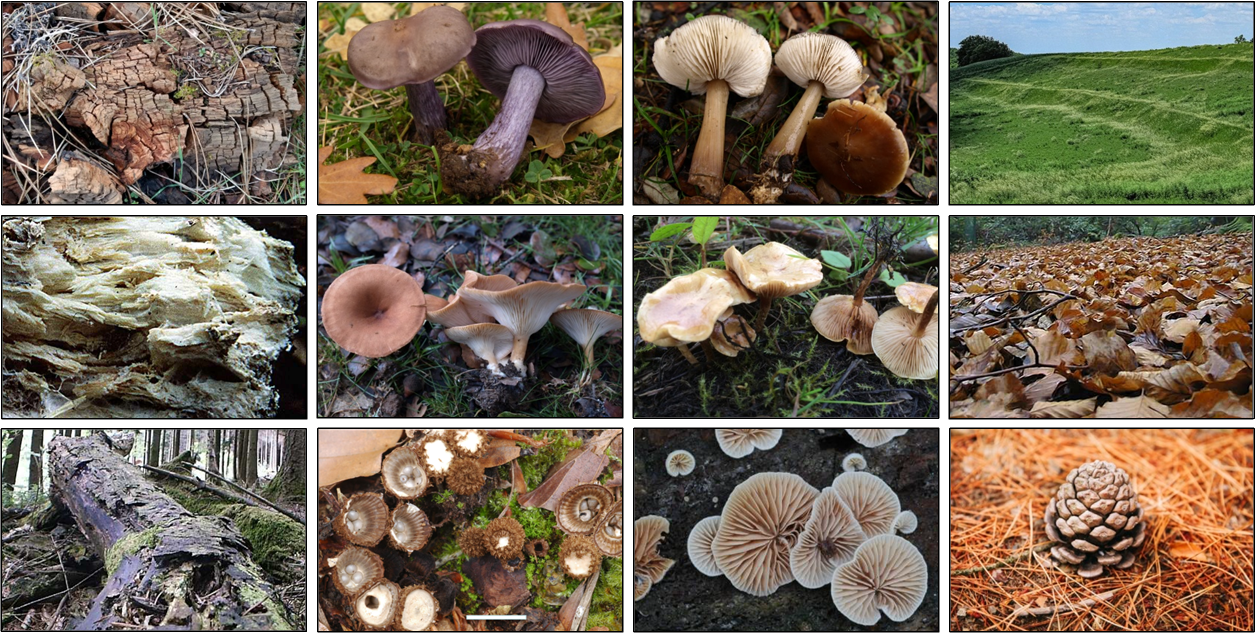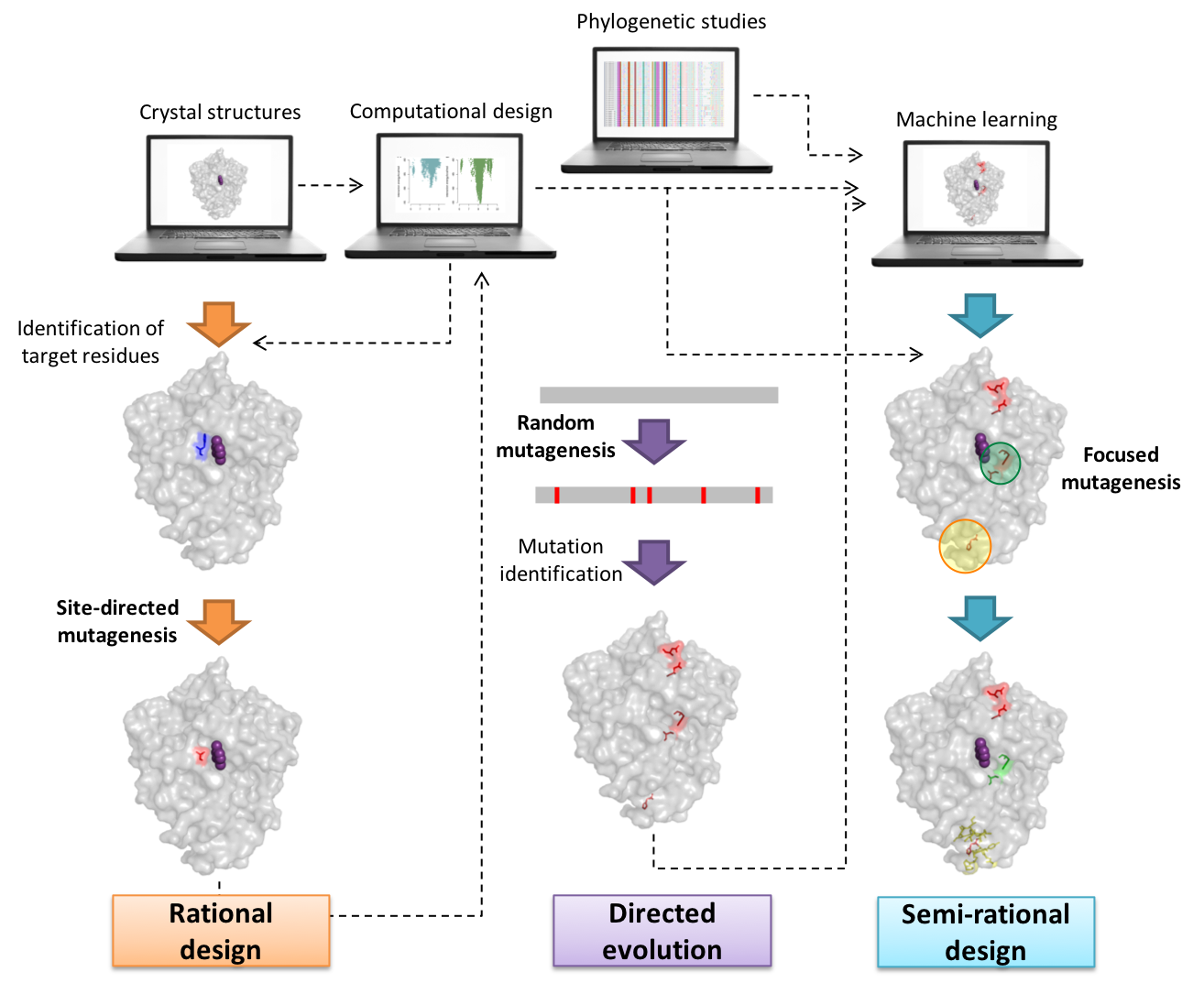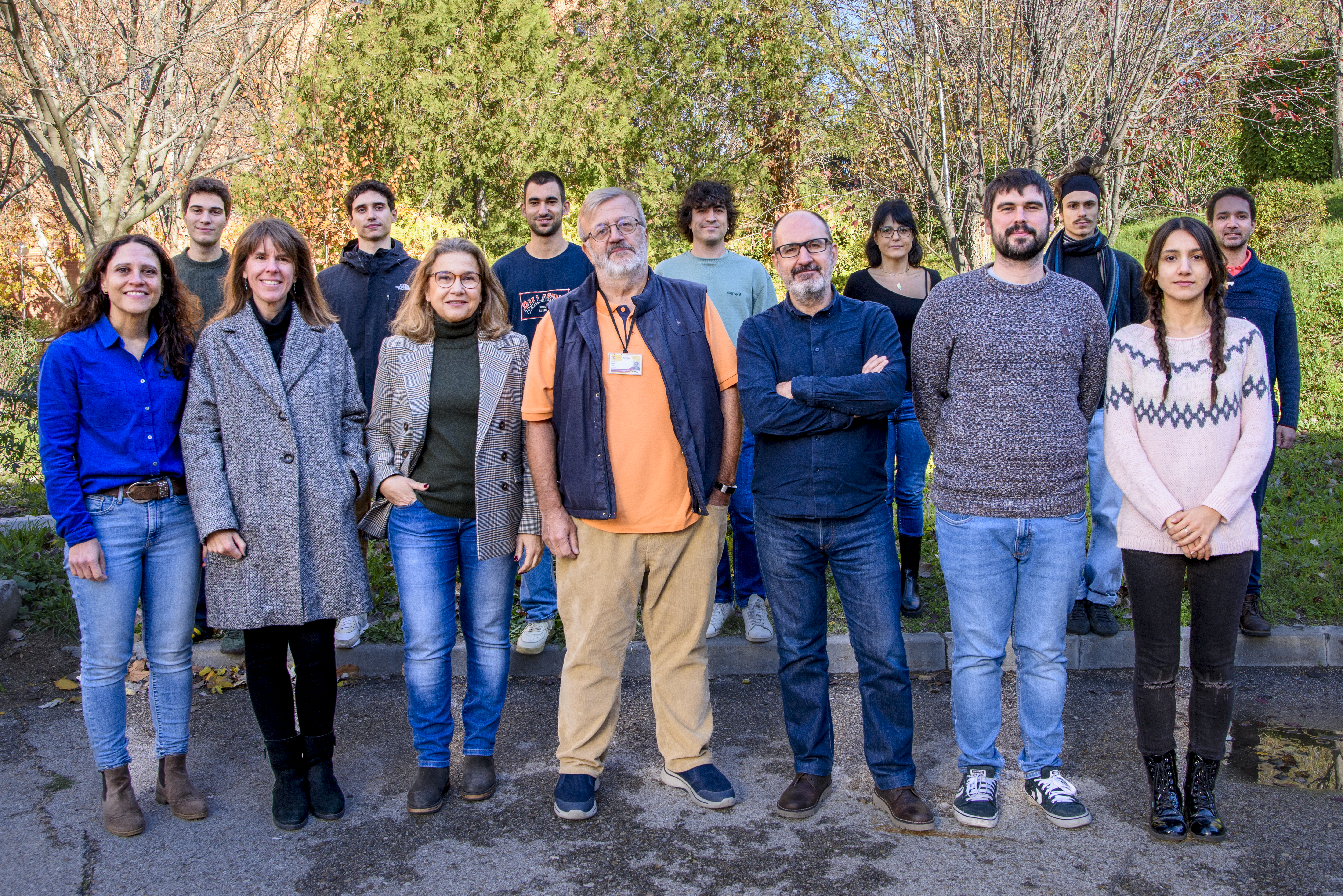Group Leader/s
intro
The scientific objectives of our group include:
1) Providing knowledge on the biological decay of plant biomass by fungi with special emphasis on lignin biodegradation, a key process for C recycling in nature and the complete exploitation of plant biomass as raw material, as an alternative to the use of fossil resources.
2) Promoting the use of these organisms and their enzymes (improved in the lab by protein engineering, computational design and synthetic biology techniques) for the industrial conversion of renewable plant biomass into bio-based chemicals and/or materials, including the synthesis of bioplastics.
3) Contributing in this way to the concept of Circular (Bio)economy through more sustainable, efficient and clean industrial processes (and with lower carbon footprint) in which organic waste (agricultural, forestry or industrial) is not generated or is used, as well as to the valorization and recycling of oil-derived plastic polymers.

To achieve the above objectives, the first step is unveiling the composition and behaviour of the enzymatic machinery responsible for the transformation of plant biomass by different species of saprophytic fungi. These studies include secretomic, transcriptomic and comparative genomic analyses, complemented with chemical analyses of degraded substrates. Our group has great expertise in oxidoreductase enzymes involved in the biodegradation of the lignin polymer and other aromatic compounds of great biotechnological interest: multicopper oxidases, heme-peroxidases, flavo-oxidases and heme-peroxygenases. Moreover, we carry out phylogenetic and evolutionary studies of all these enzymes, as well as the computational reconstruction and subsequent resurrection and characterization of ancestral enzymes. In this way, we can learn about the changes that each enzyme family has undergone during its evolution, which have given rise to the properties of extant enzymes, providing valuable information for the design of new enzymes as industrial biocatalysts.

The most interesting extant or resurrected enzymes from a biotechnological point of view, expressed in ad hoc herelogous hosts, are subjected to protein engineering through directed evolution and rational design, combined with computational design, to improve their properties or provide the new functionalities required for each specific application. The goal is to apply the new enzymes as biocatalysts in the conversion of plant materials in value-added compounds or in components of bio-based products, developing oxidation and oxyfunctionalization reactions of interest in Green Chemistry, such as those currently investigated in the FurEnPol (PLEC2021-007690), LIG2PLAST (PID2021-126384OB-I00) and OxyLipids (TED2021-129264B) projects, led by our group. More recently, we have started an innovation action funded by the Horizon Europe program and coordinated by our group (ROBUSTOO project, HORIZON-CL6-2023-CIRCBIO-01-101135119, https://www.robustoo.eu), which aims to capitalize on the results of previous EU-funded projects, WoodZymes (https://woodzymes.eu), SusBind (https://susbind.eu), and EnzOx2 (https://www.enzox2.eu). In these projects we had found the applicability of three types of oxidative enzymes, nonspecific peroxygenases (UPO), laccases and hydroxymethylfurfural oxidases (HMFO), to achieve novel and more environmentally friendly production of chemicals and materials from different plant components. To exploit their full industrial potential, ROBUSTOO is developing new, more robust enzymes, adapted to industrial application conditions, and addressing their large-scale production.
Finally, we participate in the CSIC Interdisciplinary Thematic Platform SusPlast on “Sustainable Plastics for a Circular Economy” since its launching, with the aim of contributing with biotechnological solutions to the production of bio-based plastics from renewable sources and the transformation and recycling of petroleum-derived polymers. As part of PTI+ we are responsible for the Pilot Plant for the Design of Enzymatic Biocatalysts.
The activities carried out by our group are aligned with several of the global change challenges proposed in the CSIC 2025 Strategy. In this sense, we actively contribute to finding answers to scientific challenges with a high social impact, such as those included in the ROBUSTOO, LIG2PLAST, OxyLipids and FurEnPol mentioned above. In the same way, our research work is reflected in patents and first-level high-impact international publications, as a result of interdisciplinary collaborations, which have allowed us to consolidate collaborations with national, European and American universities, research centers and companies.
Members
| Francisco Javier Ruiz Dueñas |
| Susana Camarero Fernández |
| Juan Rogelio Carro Aramburu |
| Marta Pérez Boada |
| María Dolores Línde López |
| Ivan Ayuso Fernandez |
| Rodrigo Angel Rincon Sanz |
| Gonzalo Molpeceres Garcia |
| Roberto Sevilla Ortega |
| MAria Isabel Sanchez Ruiz |
| Blanca Horta Raques |
| Beatriz Vazquez Gonzalez |
| Diego Cabrera Fernandez |

Selected Publications
Molpeceres G, Aza P, Ayuso-Fernández I, Padilla G, Ruiz-Dueñas FJ, Camarero S [2025]. Deciphering the distribution and types of Multicopper oxidases in Basidiomycota fungi. Mol. Phylogenet. Evol., 206-108310
Välimets S, Schwaiger L, Bennett A, Maresch D, Ludwig R, Hann S, Linde D, Ruiz-Dueñas FJ, Peterbauer C [2024]. Dye-Decolorizing Peroxidases Maintain High Stability and Turnover on Kraft Lignin and Lignocellulose Substrates. ACS Omega 9:45025
Sánchez-Ruiz MI, Santillana E, Linde D, Romero A, Martínez AT & Ruiz-Dueñas FJ [2024]. Structure–function characterization of two enzymes from novel subfamilies of manganese peroxidases secreted by the lignocellulose-degrading Agaricales fungi Agrocybe pediades and Cyathus striatus. Biotechnol Biofuels Bioprod 17, 74
Kapich AN, Suzuki H, Hirth KC, Fernández-Fueyo E, Martínez AT, Houtman CJ, Hammel KE [2024]. The white rot basidiomycete Gelatoporia subvermispora produces fatty aldehydes that enable fungal manganese peroxidases to degrade recalcitrant lignin structures. Appl. Environ. Microbiol. https://doi.org/10.1128/aem.02044-23
Aza P and Camarero S [2023]. Fungal Laccases: Fundamentals, Engineering and Classification Update. Biomolecules 13:1716
Rodríguez-Escribano D, de Salas F, Pliego R, Marques G, Levée T, Suonpää A, Gutiérrez A, Martínez AT, Ihalainen P, Rencoret J and Camarero S [2023]. Depolymerisation of Kraft Lignin by Tailor-Made Alkaliphilic Fungal Laccases. Polymers, 15:4433
Aza P, Linde D, Molpeceres G, Vind J, Medrano FJ and Camarero S [2023]. Role and structure of the small subunit forming heterodimers with laccase-like enzymes. Protein Sci. 32:e4734
Ferreira P, Carro J, Balcells B, Martínez AT, Serrano A [2023]. Expanding the Physiological Role of Aryl-Alcohol Flavooxidases as Quinone Reductases. Appl. Environ. Microbiol. 89:e01844-22
Sierra-Patev S, Min B, Naranjo-Ortiz M, Looney B, Konkel Z, Slot JC, Sakamoto Y, Steenwyk JL, Rokas A, Carro J, Camarero S, Ferreira P, Molpeceres G, Ruiz-Dueñas FJ, Serrano A, Henrissat B, Drula E, Hughes KW, Mata JL, Ishikawa NK, Vargas-Isla R, Ushijima S, Smith CA, Donoghue J, Ahrendt S, Andreopoulos W, He G, LaButti K, Lipzen A, Ng V, Riley R, Sandor L, Barry K, Martínez AT, Xiao Y, Gibbons JG, Terashima K, Grigoriev IV, Hibbett D [2023]. A global phylogenomic analysis of the shiitake genus Lentinula. Proc. Natl. Acad. Sci. 120:e2214076120
Aza P, Molpeceres G, Vind J, Camarero S [2023]. Multicopper oxidases with laccase-ferroxidase activity: Classification and study of ferroxidase activity determinants in a member from Heterobasidion annosum s. l.. Comput. Struct. Biotechnol. J. 21:1041-1053
Rodríguez-Escribano D, Pliego-Magán R, de Salas F, Aza P, Gentili P, Ihalainen P, Levée T, Meyer V, Petit-Conil M, Tapin-Lingua S, Lecourt M, Camarero S [2022]. Tailor-made alkaliphilic and thermostable fungal laccases for industrial wood processing. Biotechnol. Biofuels, 15: 149
Almeida N, Meyer V, Burnet A, Boucher J, Talens-Perales D, Pereira S, Ihalainen P, Levée T, Polaina J, Petit-Conil M, Camarero S and Pinto P [2022]. Use of a Novel Extremophilic Xylanase for an Environmentally Friendly Industrial Bleaching of Kraft Pulps. Int. J. Mol. Sci. 23:13423
Ayuso-Fernández I, Molpeceres G, Camarero S, Ruiz-Dueñas FJ and Martínez AT [2022]. Ancestral sequence reconstruction as a tool to study the evolution of wood decaying fungi. Front. Fungal Biol. 3:1003489
Linde D, González-Benjumea A, Aranda C, Carro J, Gutiérrez A and Martínez AT [2022]. Engineering Collariella virescens Peroxygenase for Epoxides Production from Vegetable Oil. Antioxidants 11:915
Linde D, Santillana E, Fernández-Fueyo E, González-Benjumea A, Carro J, Gutiérrez A, Martínez AT and Romero A [2022]. Structural Characterization of Two Short Unspecific Peroxygenases: Two Different Dimeric Arrangements. Antioxidants 11:891
Funding
The public EU and national financial sources are included in the list provided below, which includes: i) Project title, ii) Responsible (or coordinator); iii) Funding; iv) Funding entity and reference; and v) Duration.
A. The funded projects currently in course are listed below:
1) "Robust industrial biocatalysts with peroxygenase, phenol-oxidase or furfuryl-oxidase activities from bacterial and fungal hosts" (ROBUSTOO), EU Horizon Europe, Coordinator S. Camarero, Ref. HORIZON-CL6-2023-CIRCBIO-01-101135119, Total funding 4.45 M€, CIB 920.000 € (2024-27)
2) "Taking lessons from lignin biodegradation to degrade non-hydrolysable plastics" (LIG2PLAST), PIs: S Camarero/FJ RUiz-Dueñas, MICIN/FEDER, Ref. PID2021-126384OB-I00/MCIN/AEI/ 10.13039/501100011033/FEDER, UE, Funding: 290.400 € (2022-26)
3) "Towards selective peroxygenation of plant lipids as new industrial raw materials in bio-intelligent manufacturing" (OxyLipids), PIs: FJ Ruiz-Dueñas/AT Martínez, R&D&I Projects on Ecological and Digital Transition – 2021, Ref. TED2021-129264B/AEI/10.13039/501100011033/European Union NextGenerationEU/PRTR, Total funding 925.750 €; CIB 281.750 € (2022-2024)
4) “Enzymatic Synthesis and Recycling of Biobased Furanic Polymers” (FURENPOL), PIs: AT Martínez/FJ Ruiz-Dueñas, R&D&I Projects on Strategic Lines – 2021, Ref. PLEC2021-007690/AEI/10.13039/501100011033, Total funding: 1.038.039 €; CIB Funding: 310.406 € (2021-2024)
B. Other relevant EU or National previous projects on related topics:
“Extremozymes for wood based building blocks: From pulp mill to board and insulation products” (WoodZymes) EU H2020, Coordinator S. Camarero, Ref H2020-BBI-JTI-2017-792070, Total funding 3253873 €; CIB 738340 € (2018-21), www.woodzymes.eu
“Development and pilot production of SUStainable bio BINDer systems for wood based panels” (SusBind), EU H2020, PI-CIB: A.T. Martínez, Ref H2020-BBI-JTI-2017-792063; Total funding 4414418 €; CIB 756170 € (2018-22), www.susbind.eu
"Basidiomycete genomes for lignocellulose biorefineries" (GENOBIOREF), PIs F.J. Ruiz-Dueñas/S. Camarero, MINECO/FEDER (BIO2017-86559-R) Funding 302500 € (2018-22)
“Biotechnology for lignocellulose: towards the integral use of plant biomass as renewable resource”. Acciones de dinamización “Redes de Excelencia”. MINECO. Ref. BIO2017-90757-REDT, Funding: 15000 €; 2018 -2020. PI: S. Camarero. www.redlignocel.es
“New enzymatic oxidation/oxyfunctionalization technologies for added value bio-based products” (EnzOx2), EU H2020, Coordinator A.T. Martínez, PI-CIB F.J. Ruiz-Dueñas, Ref H2020-BBI-PPP-2015-2-720297, Total funding 3000000 €; CIB 606000 € (2016-19), www.enzox2.eu
"New oxidative enzymes for sustainable industries" (NOESIS), PIs: S. Camarero/F.J. Ruiz-Dueñas, MINECO (BIO2014-56388-R). Funding: 302500 € (2015-18)
"Optimized oxidoreductases for medium and large scale industrial biotransformations" (INDOX), EC FP7, Coordinator A.T. Martínez, PI-CIB F.J. Ruiz-Dueñas, Ref KBBE-2013-7-613549, total funding 7825824 €: CIB 928654 € (2013-16), www.indoxproject.eu
"Novel and more robust fungal peroxidases as industrial biocatalysts" (PEROXICATS), FP7, Coordinator A.T. Martínez, PI-CIB F.J. Ruiz-Dueñas, Ref KBBE-2010-4-265397, total funding 2 999 350 euros: CIB 732 114 euros, 2011-13, www.peroxicats.org
“Optimised pre-treatment of fast growing woody and nonwoody Brazilian crops by detailed characterisation of chemical changes produced in the lignin-carbohydrate matrix” (LIGNODECO), FP7, PI-CSIC A.T. Martínez, Ref KBBE-2009-3-244362, total funding 2 988 220 euros; CIB 451 250 euros, 2010-2012, https://cordis.europa.eu/project/id/244362/es
“White biotechnology for added value products from renewable plant polymers: Design of tailor-made biocatalysts and new industrial bioprocesses” (BIORENEW); A.T. Martínez (coordinator); total budget: 14 683 137 euros: total EU contribution: 9 500 000 euros; EU contribution to CIB: 1 012 388 euros; Priority-3 (NMP) of EU FP6, NMP2-CT-2006-026456; 2006-2010, https://cordis.europa.eu/project/id/26456/es

